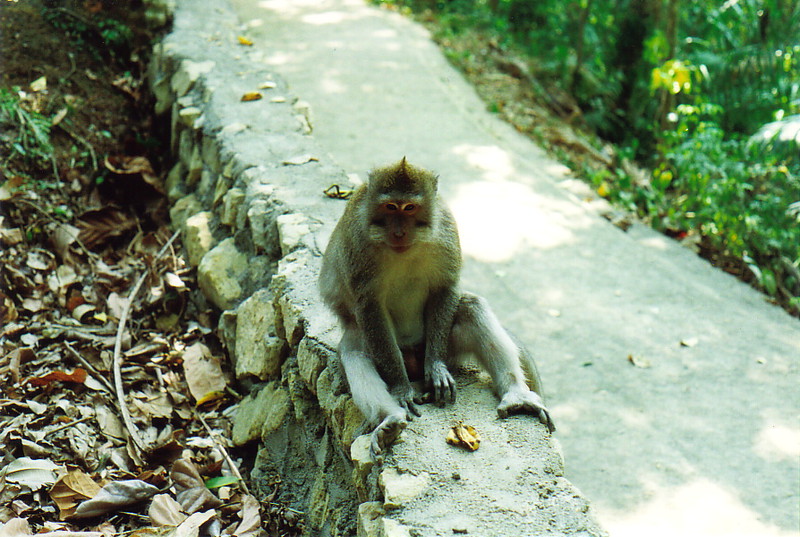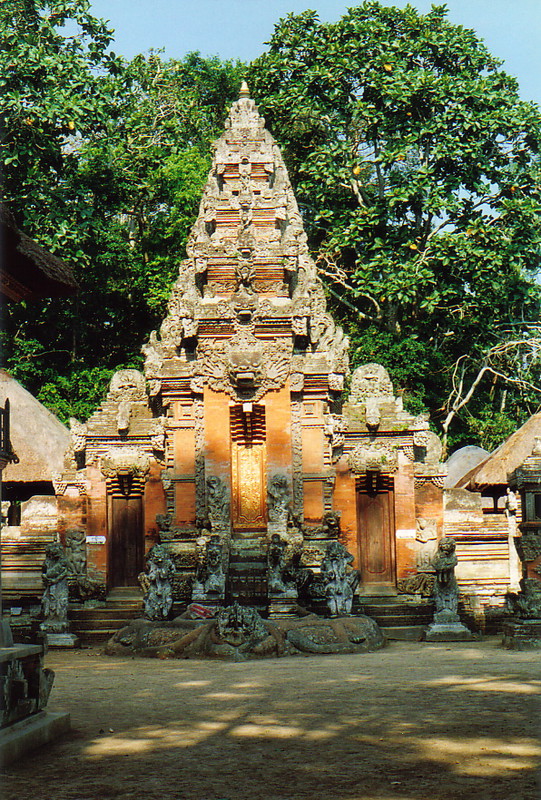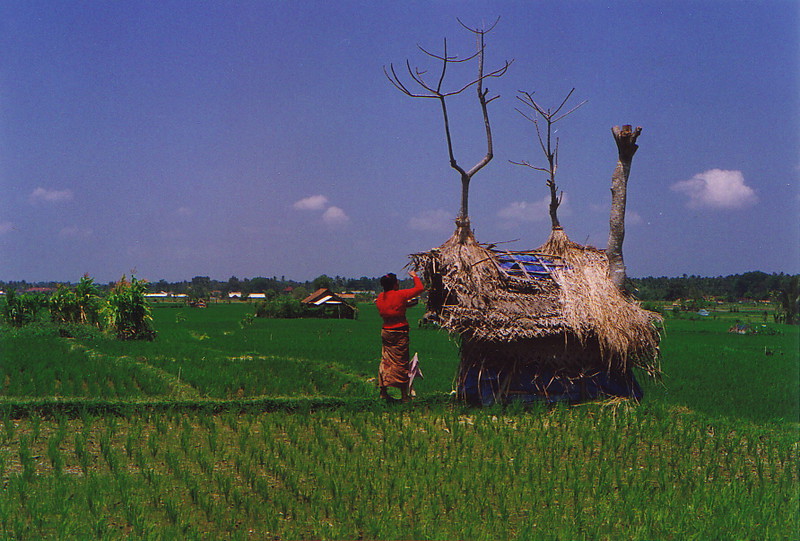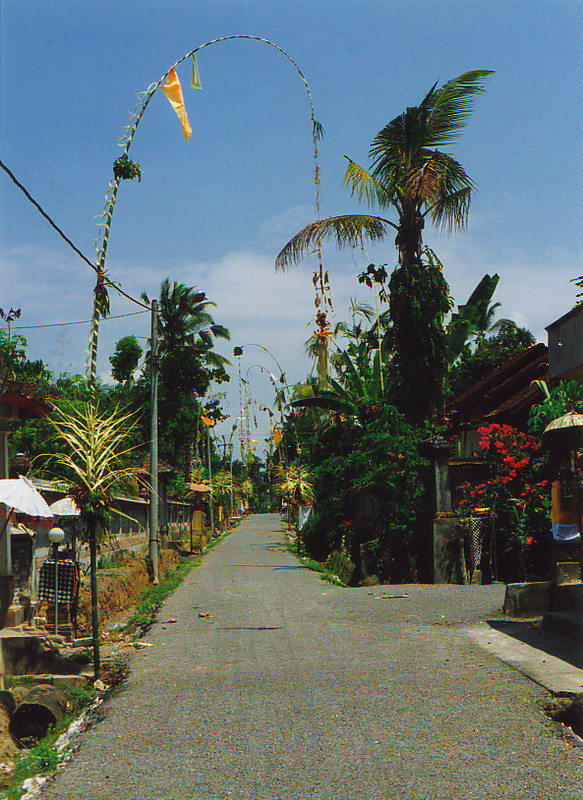
Stepping out of a bemo from Kuta into a chaotic street in Ubud, how the hell do you know where you are? The guidebook has a map, and a blob saying where it thinks you should be, but how do you find somewhere to stay that won't break the bank? So I wandered aimlessly for half a minute, and then a man on a motorbike came up to me and asked if I was looking for a room. 'How much?' I asked. '10,000rp a night,' he said. 'I'll take a look, then,' I said. 'OK,' he smiled, taking my pack and stuffing it between him and the steering wheel, and indicating that I should sit on the back.
The hotel – or losmen in Indonesian – was very pleasant, and for my 10,000rp I got a room to myself (as is standard) with two beds (a single room almost always has two beds, while a double has a double bed and a single bed) and an en suite bathroom, complete with westernised ablutions. The traditional Asian ablution involves the squat toilet and mandi, the latter being a tub of water and a scoop; you don't get in the tub, but scoop water onto yourself like a do-it-yourself shower, but in Bali, western ablutions are becoming the norm. Not only that, every room had a lovely shaded veranda to itself, and the price included breakfast, as well as coffee and tea all day. Not bad for £2.15 per day, and I was staying in fairly expensive lodgings, too. When you get all this for less than the cost of a pint of beer in London, it makes you wonder how you'll ever cope with western prices again.
For lunch I tried my second warung – a cleaner and cheaper one than the one I'd tried in Kuta – where I had a wonderful nasi campur and Coke. Nasi campur (nasi means 'rice' and campur means 'mixed') is basically rice with odds and ends, meaning you get about five or six portions of whatever's going; all of the odds and ends I had were exquisite, even if I had no idea what most of them were, and suitably stuffed, I decided to explore a bit of Ubud.
The Sights of Ubud

After soaking up the central Ubud scene, I wandered south to the Monkey Forest, a small and almost dead forest populated by a large Balinese temple and an even larger population of monkeys. If you imagine that scene from Disney's Jungle Book then you're not far off what the Monkey Forest could be; huge trees slowly being crushed by strangling figs, pesky monkeys attacking tourists for peanuts, vines hanging off temple buildings – it could be so wonderful, but it's actually rather sad. The forest is dead, the monkeys are only after one thing – food – and the tourists are only there to take their pictures so they can say they've 'done' the monkeys in Bali. Never mind, I suppose it's one way to fill up the afternoon.
It was also my first experience of the entry fee system in Bali. Most things have an entry fee, which is fine because it's normally something like 10p, but you not only pay entry for yourself, you pay a fee for your camera too, and if you've got a video camera, the charge is even more. It seems a bit strange at first, but you soon get used to it, though I never really understood why some tourists hid their compact cameras in their bags to avoid paying a few rupiah; if you don't pay, you can't expect the sights to be protected from the sort of decay that the Monkey Forest demonstrates all too sadly.
That night I shelled out to visit the ballet. Balinese dance is something else; it's totally different to western dancing, and is a step beyond Polynesian tribal displays. It's quite beautiful, with its combination of colourful and ornate dress, strange pentatonic and diatonic orchestral music played on the local equivalent of the xylophone, and eye and hand movements that are surprisingly expressive. The ballet I went to see, the Ramayana, was the story of the kidnapping of a beautiful girl by a demon, and helped along by some notes in English describing the plot, I found it a wonderful experience. The 'stage' was open air and in the round, set up very much like a temple with burning butter lamps and beautiful stone carvings everywhere, and as the moon rose over the whole proceedings, I really felt for the first time that here I was, in a radically different culture, rather than just a radically different lifestyle.
The only drawback was that every time a new character hit the stage, the camera flashes went off like the Oscars when the stars arrive. Ah well, Bali is a tourist trap, and Ubud is its cultural heart, so I guess I should have seen that coming...
Around Ubud

My second day in Ubud turned out well, too, despite a rather unpromising start. Waking up leisurely and enjoying a breakfast on the veranda felt pretty damn luxurious after all the lame breakfasts I've had to make for myself over the last two years, but on visiting the centre of the sprawling metropolis of Ubud, I found it comparatively dead. The public holiday that was in force, set to coincide with September's full moon, turned out to be more of a holy day than a holiday; everyone disappeared into the temples, leaving the shops closed and the streets rather quiet, except for the beautiful bamboo poles set up by the sides of the road, which bent over the streets like decorated street lamps, with wind chimes dangling off the ends and gently tinkling in the breeze. I suppose it would be similar to a non-Christian turning up on expecting a riot, only to find empty streets stuffed with Santa decorations, Christmas trees, and closed shops. Never mind; if the town centre was sleeping, I'd simply go exploring the surrounding countryside.
Walking west out of Ubud, I soon left the hotels and restaurants behind, and headed off into my first experience of rural Bali. Coming round a corner, I was confronted by lush green meadows, which on closer inspection turned out to be paddy fields. Dotted throughout the fields were flags on large poles, stone pillars where floral offerings were being made to the gods, little thatched shelters, and people working the fields (though not many, as most were praying somewhere else). I stopped to take a quick break on the side of the road, fishing out my inadequate map in the process to try to work out where I was, and before you know it I was accosted by this elderly man, all dressed up in the basic farmer's garb of sarong, flip-flops and baggy shirt. Smiling, he asked me in English where I was from.
So, we got talking. He introduced himself as Made Tunas (pronounced 'Maday Toonas') and said he lived in Sayan, a village some 2km west of central Ubud, and home to huge spreads of paddy fields. He offered to guide me to his village, which seemed a sensible prospect seeing as I wasn't exactly sure where I was, and we strode off towards the nearest paddy field.

Given that I was wearing my new cotton trousers – I was trying to look respectable, so as not to offend the locals – I wasn't too keen on marching through the quagmire that makes a paddy field a paddy field, but, of course, I hadn't been thinking. Criss-crossing all paddy fields are perfectly dry paths; paddy fields are effectively fields fed by man-made streams, and to keep the water in they need sides. These are what you walk down, sometimes hopping across flowing streams on bamboo sticks, sometimes scaling steep terraces, but mainly just wandering through a confusing but fairly logical network of little raised tracks. Every few metres is a little statue or stone monument – it seems each field needs its own little offering spot to ensure the gods make the rice grow – and there are also plenty of wind-powered rattles that play out a strange tune, not a million miles from the sound a wooden wind chime makes. Combine this with the Hindu singing you often come across, and it's a step into another world. I felt deeply spooked to be wandering through a segment of photographic pastiche as the sun beat down mercilessly; after all, how many pictures of paddy fields being worked have I seen? Countless. And how many paddy fields have I actually explored? Well, none... until now.
Arriving in the little village of Sayan, we took a few sharp turns down tiny alleyways, and before long Made Tunas pointed to a collection of ramshackle and crumbling buildings and proclaimed, 'This my house.' We sweltered across a small courtyard and sat down in the shade, and while the ducks clacked around, the dogs sniffed at the daily offerings1 and the cows in the field snored and chewed the cud, Made Tunas offered me a drink.
Thinking quickly, I asked him if he had any tea; after all, tea has to be heated somewhere along the way, and I figured that I was probably going to get as sick as a dog if I ate or drank anything at all, but tea might just be all right. Off he pottered to put the proverbial kettle on, and I sat down to examine the area. There were four small houses around the courtyard, with some beds kicking around (though to call a flat wooden palette a bed is a bit of an exaggeration) and odds and ends everywhere. Off to one side was a small, private temple area, decorated with beautiful cloths and flower arrangements, and the smell of incense wafted over in the gentle breeze. When Made Tunas came back with a grotty glass full of sweet but worryingly tepid tea, I gingerly sipped it, finding a delicious and refreshing sweet drink, containing goodness only knows what. We made small talk – his English was quite passable, something that surprised me for a farmer – and he showed me the woodcarvings that his son made and sold in the market, even giving me a little wooden tortoise as a present. Of course, I knew all this was going to cost me something in the end, but I was having such a sensory overload that I figured it would be worth it.
After a while, during which I picked up some more Bahasa Indonesia, I declined his kind offer of some food, figuring that eating would really screw up my intestines, and we set off back through the paddy fields, heading towards the road to Ubud. When we finally reached the road, I offered to give him some something ('I have nothing to give you, but perhaps some money...?'), and after some gentle negotiation I coughed up a pretty paltry sum; he seemed happy enough, and I reckoned I'd got a fair old experience for my cash. Satisfied but hungry, I set off back into Ubud, picked up a wonderful spicy chicken dish at a restaurant on the way, and ducked back into the hotel for a well-earned siesta. I slept like a baby...
1 Throughout Bali you'll see these little offerings on the street, in the houses... pretty much everywhere, in fact. Consisting of a small tray made of woven leaves, filled with dried flowers, a couple of rice balls and an incense stick or two, they're put out every morning outside the front door, where the dogs come and eat the rice, the motorbikes drive over them and the ravages of the world turn them into a squashed mass on the highway of life. Still, the next day there's another one, and they're a pretty pleasant way of littering the streets with biodegradable art.